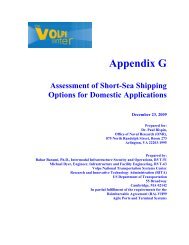ERRV Viking Islay - Marine Accident Investigation Branch
ERRV Viking Islay - Marine Accident Investigation Branch
ERRV Viking Islay - Marine Accident Investigation Branch
- No tags were found...
Create successful ePaper yourself
Turn your PDF publications into a flip-book with our unique Google optimized e-Paper software.
Section 2- ANALYSIS2.12.22.32.3.1AimThe purpose of the analysis is to determine the contributory causes and circumstancesof the accident as a basis for making recommendations to prevent similar accidentsoccurring in the future.FatigueThe effect of fatigue on the master and crew of <strong>Viking</strong> <strong>Islay</strong> was assessed. The crewwere fresh from 28 days leave; the two day workers had had a full night’s rest. MrMacFadyen had been off-watch for his full 8 hours, albeit to some (not fully known)extent disturbed by the noise made by the anchor chain. However, if his rest had beenseverely disturbed, he would have been able to temporarily move from his cabin to aquieter location to sleep (e.g. the ship’s hospital or survivor accommodation); there wasno evidence to suggest that he had done this. Also, other members of the crew did notreport significant sleep disturbance caused by the noise from the chain locker, indeedsome were not aware of the noise at all. Therefore fatigue was considered not to be acontributory factor to this accident.Manning & personnelManning levels<strong>Viking</strong> <strong>Islay</strong> was manned well in excess of the vessel’s minimum safe manningdocument. A lack of manpower on board <strong>Viking</strong> <strong>Islay</strong> was not a contributory factor tothis accident.2.3.2 Crew nationalities and languages spoken on board <strong>Viking</strong> <strong>Islay</strong>All of those interviewed had satisfactory spoken English skills; there is no evidence tosuggest that language difficulties played any part in this accident.2.4The hazardAir quality measurements showed that at the time of the accident the atmosphere in thechain locker was O 2 deficient, and that no other gaseous hazards existed. Subsequentexpert analysis has shown that this deficiency was due to depletion, rather thandisplacement or dilution of the O 2 , and that the O 2 levels could have been sufficientlylow – around 4.4% - so as to cause instantaneous collapse of any person breathingsuch an atmosphere. This supports the recollections of the witness who saw MrMacFadyen collapse in this way. It is therefore very likely that the first two victims weresimilarly overcome.The chain locker had no natural ventilation other than via the spurling pipes, and itwas practice on board <strong>Viking</strong> <strong>Islay</strong> for these to be sealed with expanding foam oncethe vessel was clear of harbour and had secured her anchors for sea. Over the18 months since the compartment had last been gas-freed and proven for normalatmosphere, the rusting of the inner surfaces of the compartment and the chain wouldhave been steadily depleting the O 2 in the air. Rusting is invariably found within chainlockers, given the intermittent presence of damp conditions and exposed steel. Thebreaking free of the anchor chain to enter and leave harbour, sometimes followed27
















